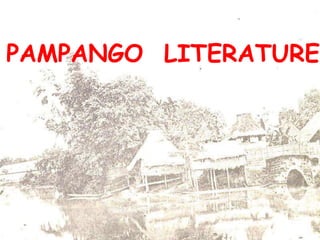Pampango Literature
- 2. HISTORICAL BACKGROUND ? The name was derived from the native Kapampangan words "pangpang ilog" meaning "riverside" where the early Malayan settlements were concentrated along the Rio Grande de la Pampanga ? Pampanga is well-known for its rich delicacies and cuisines ? literature flourished during the early years of Pampanga: ? Literature introduced through the Spanish-speaking elites and the native-speaking friars ? Oral lore which continued to serve the needs of the working class in the still predominantly agricultural province
- 3. ? Riddles, sayings, folksongs, childrenĄŊs rhymes, legends and folktales reflected the flora, fauna and the geographic features of the province
- 4. Riddles ( Bugtong ) ? The Kapampangans love exchanging bugtung or riddles at social events, funeral wakes and weddings. ? favorite past time during the war, playing ĄŪbugtunganĄŊ was widely practiced in rural areas to while away time during long walks home
- 5. Kasebian ( Sayings) 1. Matas at mataluctuc masaldac ya pangabaldug. (The higher the climb, the harder the fall.) 2. Ing paro macabaluctut dalan ne ning masalusung agus. (A bent shrimp allows the current to pass through.) 3. Ing asung macabaluctut butul man e macapulut. (A lazy dog will not find even a bone.) 4. E ca lalapit qng api nung e ca bisang mapali. (DonĄŊt come near a fire if you donĄŊt want to risk being burned.) 5. E mangaplas ing alang sugat. (If thereĄŊs pain there must be a wound.)
- 6. Diosdado Macapagal ? the ninth President of the Philippines ? native of Lubao, Pampanga ? His works include Gripu (Artesian Well)
- 7. Jose M. Gallardo ? wrote over 200 poems,26 plays and zarzuelas, six novels and dozens of short stories, ? best known work is Crucifijo Ng Pilak which was staged more than 100 times between1956 and 1972
- 8. Aurelio Tolentino ? Filipino playwright, poet and journalist ? He was arrested twice, first by the Spaniards and later by American forces. ? He wrote and directed the anti-imperialist play Kahapon, Ngayon at Bukas (Yesterday, Today and Tomorrow) which led to his arrest in 1903
- 9. Juan Crisostomo Soto ? Journalist, poet, playwright ? Father of Pampanga Literature ? Santa Ines, Bacolor, Pampanga.









